

Placemaking vs. Placeshaking. Earlier this month, writing about successful neighborhood planning, my fellow PlaceMaker Howard Blackson used the term “placeshaker” as a catch-all for the grass roots engagement efforts that empower, but don’t necessarily define, placemaking.

That got me thinking. Even though our firm is called PlaceMakers and our blog, PlaceShakers, I’ve never really given a lot of thought to the distinction between the two. Axiología de las ICs. En la actualidad buena parte del debate de numerosos agentes y lugares acerca de la dilucidación de las prácticas innovadoras y emergentes de las Iniciativas Ciudadanas -ICs- versa sobre su valoración, evaluación y reconocimiento.

Ello conlleva la pretensión de ordenar la multitud de ICs insertas en un ecosistema heterogéneo, cambiante y difuso, del cual resulta difícil aprehender prácticas innovadoras que permita el establecimiento de “cierta” valoración de las mismas. Mayor seguridad requiere mejor espacio público. Por Martín Marcos.

Arquitecto y urbanista. Challenges and Warts: How Physical Places Define Local Economies. Project for Public Spaces. Tactical Urbanism. The Official Guide to Tactical Urbanism - Neighborhoods. Www.bogotabasuracero.com/pdf/brochure-bbc2.pdf. Www.cl.cam.ac.uk/~sjm217/papers/digiact10all.pdf. Tactical Urbanism Volume 1. Urbanismo Emergente o “Tactical Urbanism” Intervenciones Urbanas - Acciones tácticas de comunicación. Stevenberlinjohnson.com. Emergent Urbanism, or ‘bottom-up planning’ I was asked to write an article around ‘bottom-up planning’ by Architectural Review Australia a while ago.
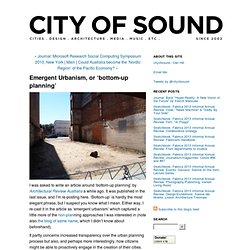
It was published in the last issue, and I’m re-posting here. ‘Bottom-up’ is hardly the most elegant phrase, but I suspect you know what I mean. Either way, I re-cast it in the article as ‘emergent urbanism’ which captured a little more of the non-planning approaches I was interested in (note also the blog of same name, which I didn’t know about beforehand). It partly concerns increased transparency over the urban planning process but also, and perhaps more interestingly, how citizens might be able to proactively engage in the creation of their cities.
While it applies to Australian cities most closely, I hope the ideas here might be more generally interesting. And for those of you outside Australia, there are a few subtitles required to read this. In short, the city of Newcastle, NSW is the largest coal port in the world. Urbanismo Tactico: Volumen 2. DIY Urbanism. The current economic crisis has proven to be more than a challenge to our wallets: it has tested our faith in personal agency and our optimism in the future.
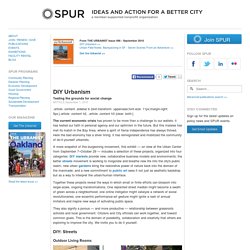
But this malaise has met its match in the Bay Area, where a spirit of fierce independence has always thrived. Here the bad economy has a silver lining: it has reinvigorated and mobilized the community of do-it-yourself urbanists. A mere snapshot of this burgeoning movement, this exhibit — on view at the Urban Center from September 7–October 29 — includes a selection of these projects, organized into four categories. DIY markets provide new, collaborative business models and environments; the better streets movement is working to invigorate and breathe new life into the city's public realm; new urban gardens bring the restorative power of nature back into the domain of the manmade; and a new commitment to public art sees it not just as aesthetic backdrop but as a way to interpret the urban/human interface.
International Federation for Housing and Planning. Play Me, I’m Yours. DIY Urbansim: City Building from the Bottom-Up. Bottom-Up « OpenSourceUrbanism. HomeGrown Cities Project // URBZ A couple of days ago, I received an e-mail from the URBZ team, explaining the project “Homegrown cities” that they are developing in the city of Mumbai.
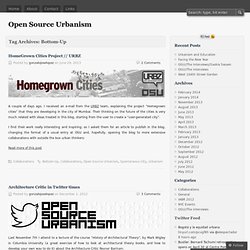
Their thinking on the future of the cities is very much related with ideas treated in this blog, starting from the user to create a “user-generated city”. I find their work really interesting and inspiring, so I asked them for an article to publish in the blog, changing the format of a usual entry at OSU and, hopefully, opening the blog to more extensive collaborations with outside the box urban thinkers: Arquitectura en Beta – Urbanismo Emergente. Pattern Cities » Archive » The Difference Between Tactical and DIY Urbanism. Image by Gordon Douglas, via Good Bravo to Good for their nice profile of DIY urbanism initiatives–From Portland to Los Angeles to New York (all pattern cities), they provide many exciting examples.

While there is some obvious crossover between the DIY efforts included in the GOOD piece and our Tactical Urbanism report–which was published on this website a few weeks ago–the recent spate of articles on the subject is now beginning to illuminate two important differences. One, DIY efforts are enacted from the bottom-up, not the top down. In other words, individuals or small groups of people work together to make an improvement or to communicate a message, typically at the scale of the urban block or building. Urbanismo emergente: ciudad, tecnologa e innovacin social. A finales del año pasado SEPES Entidad Estatal de Suelo publicó la monografía Paisajes Domésticos / Domestic Landscapes en donde, en seis volúmenes, se documentan los proyectos en ejecución que resultaron seleccionados en el Proyecto VIVA ("Vivienda de Vanguardia"), un concurso internacional de ideas de SEPES y el MInisterio de Vivienda (más información en la sección de publicaciones del sitio de SEPES).
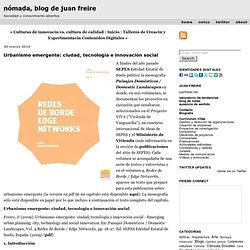
CNU20 Report: DIY Urbanism. This is a community post, untouched by our editors.
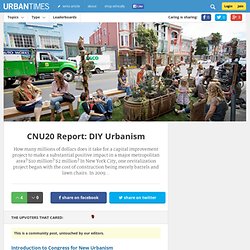
Introduction to Congress for New Urbanism How many millions of dollars does it take for a capital improvement project to make a substantial positive impact in a major metropolitan area? $10 million? $2 million? In New York City, one revitalization project began with the cost of construction being merely barrels and lawn chairs.